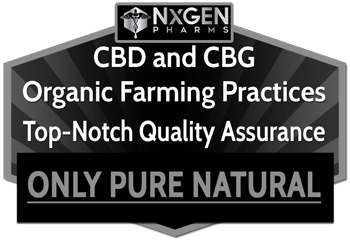CBD/CBG use has become increasingly popular over the last couple of years as a natural alternative. If you're new to CBD/CBG, then you've landed in the right place.
Here, we’ll answer some of the most pressing questions related to CBD/CBG for explain the difference between CBD/CBG and THC.

CBD/CBG (cannabidiol) are some of over 60 active chemical compounds (or ‘cannabinoids’) in the marijuana plant. It’s usually the second-most abundant cannabinoid, behind THC.
Marijuana and hemp are two different varieties of cannabis that come from the same species of plant (Cannabis sativa L). In general, CBD is found abundantly in both. However, it’s important to note that CBD/CBG is typically found in the seeds and stem of marijuana - not in the flowering buds (which is the part that you smoke). The hemp plant is an entirely different strain of cannabis that contains high quantities of CBD/CBG throughout (stem, buds, etc), and practically zero traces of THC. If a hemp plant contains more than 0.3% THC, it is then technically a “marijuana” plant. Most all CBD-based products come from the industrial hemp plant.
THC affects the brain by binding to naturally-occurring CB-1 receptors in the central nervous system. CBD is a differently-shaped molecule that binds to CB-2 receptors in cell and body tissues outside the central nervous system.
No, CBD/CBG will not get you high. It's non-intoxicating. Like we just said THC is the molecule that binds to receptors in our brain and is the one responsible for the psychoactive effects of marijuana. In fact, CBD/CBG is antagonistic to the marijuana high; some research expresses its potential to prevent THC molecules from binding to the brain’s receptors (hence the reason why it’s often used to subdue the ‘paranoia’ effects of super-potent THC strains).
Most CBD/CBG products are taken orally via oil drops that are placed under the tongue and held for 60 seconds before swallowing. Topical creams and ointments are also effective, as is smoking or vaporizing CBD-rich marijuana strains like ACDC or Charlotte’s Web.
Other than Charlotte’s Web and ACDC, Harlequin is probably the most popular CBD-dominant cannabis. Others include CBD Mango Haze, Blueberry Essence, Hawaiian Dream, Sour Tsunami, and Darkstar, just to name a few.
CBD/CBG oil is a liquid cannabis extract that contains virtually pure CBD/CBG. It’s commonly made from seeds of the hemp plant (CBD/CBG hemp oil) and the stem of industrial hemp.
CBD functions by binding to cannabinoid receptors in the body’s endocannabinoid system. These receptors have been found in virtually every cell and tissue type in the human body (hence the seemingly endless array of CBD uses).
In states where MMJ is legal, any CBD product (whether it comes from hemp or marijuana) is of course perfectly legal. Outside of these legalized states (including shipping from legal to non-legal states), things tend to be a little less clear. According to ProjectCBD.org, “Federal law prohibits U.S. farmers from cultivating hemp as a commercial crop, but the sale of imported, low-THC, industrial hemp products is permitted in the United States.” Technically, this means that as long as the CBD CBD/CBG less than 0.3% THC), it is permissible to buy, sell, and ship across state lines. (However, in articles like 2014’s Farm Bill, the exact rule seems to be a little less clear). All in all, the fact remains that millions of people buy and use CBD products every day of their lives, and this option is only getting more popular and widespread with each passing day.
Yes, CBD is a 100% naturally-occurring chemical compound that comes directly from the cannabis plant. It is not synthetically made.
Not all marijuana strains have CBD in their flower buds. But yes, every cannabis plant (whether it’s marijuana or hemp) will have CBD in the stem and seeds.
CO2 extraction is the best method to extract pure CBD/CBG isolate, in which state it exists as a clear/white crystal. This method is preferred over other methods because it leaves practically zero traces of chemical contaminants in the end product. Alcohol extraction is another method, wherein a liquid such as ethanol, butane, or hexane is run through raw plant material to extract the CBD and then evaporated to leave only the active cannabinoid. This can be a dangerous method because it’s prone to leaving excess traces of the butane or hexane chemicals in the extract. Also, infusing vegetable oil (i.e. olive oil) is another effective way of extracting CBD. All you do is grind up the raw plant material, decarboxylate (heat) it, and let it sit in boiling (100-deg Celsius) oil for about 2 hours.
The only significant danger/side effect of the drug is in vaping CBD/CBG oils that were produced using a thinning agent, such as propylene glycol. When burned/vaped, propylene glycol produces formaldehyde, which is a known carcinogen. CBD oils produced by CO2 extraction are much safer and purer than oils that were produced with liquid alcohol/thinning agents. Other than that, most research has concluded that CBD is perfectly safe with no known side effects, though some users have reported drowsiness, lightheadedness, low blood pressure, and dry mouth.
Absolutely! CBD infused oils are a fantastic ingredient to cook with.
Thousands of scientific studies have been carried out specifically on CBD. Project CBD is a non-profit organization strictly dedicated to documenting the research progress on this incredible drug.
CBD topicals have proven effective for a number of circumstances. Many individuals swear by them.
A high-quality CBD/CBG product with minimal THC is incredibly unlikely to show up on a drug test. However, low quality CBD/CBG products may contain more traces of THC than they claim, in which case it is possible for a screening to pick up on the drug. (Research has shown that people who consume 6 mg of THC per day have a 25% chance of failing a drug test. This translates to about 2,000 mg per day of CBD oil with a THC content of 0.3% or less).
This one is tricky because it, of course, depends on what you’re using the compound for, and also on how strong the product is. Most people consume between 10-50 mg of CBD per day total. (For reference, 1 mL of a potent oil might contain 50 mg of CBD. Make sure you read the label on your product to ensure a proper serving.
To ensure the legality of buying CBD/CBG products online, you need to make sure the company you’re buying from is reputable and that the product was made from industrial hemp with less than 0.3% THC content. While transporting marijuana across state lines (from legal to non-legal states) is against the law, transporting hemp and hemp-based products is safe. Remember, millions of people all over the US (and the globe) are using CBD/CBG products every day.
Contact Us:
Thanks for your message! We’ll be in touch soon.



